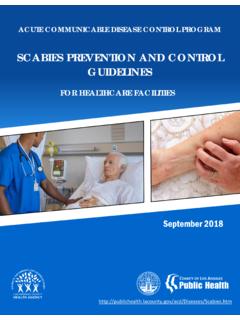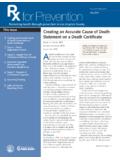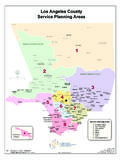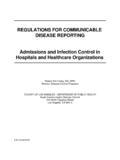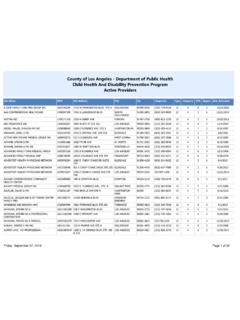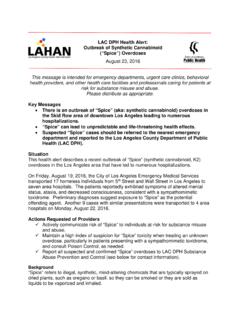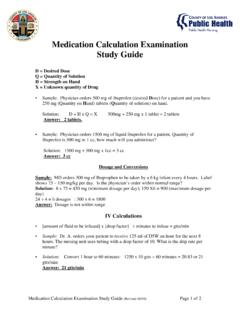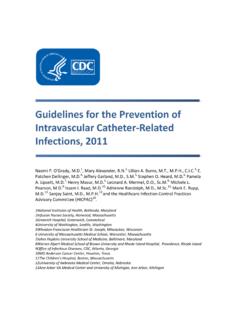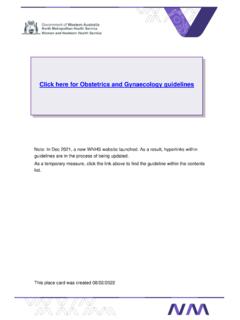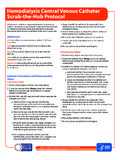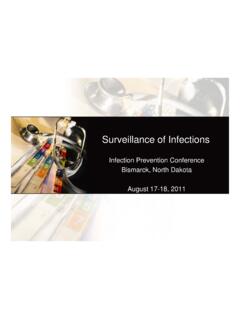Transcription of SURVEILLANCE AND INFECTION PREVENTION
1 Mamta Desai, BS, MBA, CLS, CICD irector of Epidemiology and INFECTION PREVENTION SURVEILLANCE AND INFECTION PREVENTION Objectives Define SURVEILLANCE and its role in an INFECTION PREVENTION and control program Describe types of SURVEILLANCE Advantages and disadvantages of various SURVEILLANCE strategies How to conduct INFECTION PREVENTION Risk Assessment and develop a plan 2013 Pomona Valley Hospital Medical Center2 QuestionWhat do you think of when you hear the word SURVEILLANCE ? QuestionWhat do you suppose is the definition of SURVEILLANCE when applied to INFECTION PREVENTION and control?
2 INFECTION PREVENTION & Control (IPC) SURVEILLANCE Cornerstone of all successful hospital IPC program IPC SURVEILLANCE is only the starting point and benchmark for assessing the need for intervention strategies Effective SURVEILLANCE involves Counting cases and then Calculating rates of various infections Analyzing these data Reporting the data in an appropriate way to personnel involved in patient care Challenges Changing healthcare delivery system Emerging and reemerging infectious diseases Mandatory reporting requirements 2013 Pomona
3 Valley Hospital Medical Center8- Lord Kelvin If you don t measure it, you cannot improve it 9 Should be based on sound epidemiological and statisticalprinciples Designed in accordance with current recommended practices Needs to be able to identify risk factors for INFECTION Adverse events Implement risk-reduction measures Monitor the effectiveness of intervention Identify Outbreaks Emerging infectious diseases Antibiotic-resistant organisms Bioterrorist eventsComponents of a Strong SURVEILLANCE Program10 Components of a Strong SURVEILLANCE Program Include INFECTION
4 PREVENTION Performance improvement Patient safety Public health activities Mandatory and public reporting requirements SURVEILLANCE data Reduce the occurrence of infections by using risk factors andimplementation of risk-reduction measures and monitoringeffectiveness of Ongoing collection and analysis of data and the ongoing dissemination of information to those who need to know so that action can be taken. Reference: Last JM, ed. A Dictionary of Epidemiology. 4th ed. New York: Oxford University Press; 2001:174 SURVEILLANCE is an essential component of an effective INFECTION PREVENTION program.
5 First recommended for hospitals by the American Hospital Association in 1958 Staphylococcus aureus 1960 CDC 1976 Joint CommissionSurveillance Definition and HistorySENIC PROJECT 1985 Study on the Efficacy of Nosocomial INFECTION Control Scientific evidence that hospitals with strong SURVEILLANCE program has strong PREVENTION and control program improved patient outcomes by reducing HAI Since 1985 healthcare delivery systems has shifted outside of the acute care hospital Publication of SURVEILLANCE recommendations for outpatient settings, LTC, rehab, ASC, dialysis, home care, hospice, mental health, and correctional facilities 2013 Pomona Valley Hospital Medical Center12 Purpose of SURVEILLANCE Provide data to conduct a facility risk assessment for health care associated INFECTION , diseases, such as legionellosis or tuberculosis Ensure compliance with state and federal regulations and state mandatory reporting requirement Meet requirements of accrediting agencies.
6 Such as the Joint Commission and the Commission on Accreditation of Rehabilitation Facilities (CARF) Provide information for the education of healthcare personnel Monitor injuries and identify risk factors for injuries in personnel Detect an emerging infectious disease or a bioterrorist event 2013 Pomona Valley Hospital Medical Center13 Types of SURVEILLANCE Total or Whole House SURVEILLANCE Monitors allHAI in the entire facility Overall facility INFECTION rate should not be calculatedRates should be calculated for specific HAIs in a defined population Example.
7 Central line-associated bloodstream infections MRSA Blood Stream INFECTION 2013 Pomona Valley Hospital Medical Center14 Types of SURVEILLANCE Overall facility rates are not sensitive enough to identify problem or not adjusted for specific INFECTION or injury risks so they are not appropriate for: measuring trends over time Comparisons between groups Benchmarking Although ideal most facilities do not have the technical and personnel resources to do house-wide SURVEILLANCE Target SURVEILLANCE is generally conducted 2013 Pomona Valley Hospital Medical Center15 Types of SURVEILLANCE Target SURVEILLANCE 1990 CDC shifted from total house SURVEILLANCE to target SURVEILLANCE (NNIS system) Focuses on.
8 Particular care units ( , ICU, nurseries etc) infections related to devices ( , intravascular and urinary catheters) Invasive procedures ( , surgery) Organisms ( , resistant organisms such as MRSA, VRE, ESBL, etc) Focuses on high-risk, high-volume procedures and adverse outcomes that are potentially preventable 2013 Pomona Valley Hospital Medical Center16 Review Historical data & Volume 2013 Pomona Valley Hospital Medical Center17 INFECTION Definitions Acute Care 2013 Pomona Valley Hospital Medical Center18 Collection Data to collect depends on the event being monitored Data collection for infectious events: Demographics:name, sex, age, unique identifier (MD #, acct.)
9 # unit, MD, date of admission, date of onset of INFECTION , type of INFECTION , date of discharge, transfer, or death Information needed to determine whether the case definition is met:lab results, diagnostic tests, dates performed, sites and dates cultured and organisms isolated, antibiotic susceptibility, clinical signs and symptoms specific for the INFECTION being monitored. Risk factors for the INFECTION being monitored:underlying conditions and diseases, surgical procedure and date performed, including surgeon, ASA score, wound classification, use of IV catheters including date of insertion and duration of use etc.
10 2013 Pomona Valley Hospital Medical Center20 Data Collection Tool 2013 Pomona Valley Hospital Medical Center21 Numerator/Denominator Numerator: the upper portion of a fraction used to calculate a rate or ratio. In SURVEILLANCE , it is usually the number of cases of a disease or event being studied. Denominator: the lower portion of a fraction used to calculate a rate or : 5 UTIs/135 Catheter Days = rate5 is the Numerator 135 is the Denominator Denominator can be: census (rarely used), patient or resident days, device days, number of visits, number of surgical site cases (by type of surgery) 2013 Pomona Valley Hospital Medical Center22 Standardized INFECTION Ratio (SIR) Provides improved risk adjustment and replace risk-stratified SSI rate Risk models developed specific for each procedure Example: SSI Risk factors for C-Section Proc.
